Strategic Analysis: Leading E-Strategy, Ensogo's Failure and Recovery
VerifiedAdded on 2023/04/23
|21
|5789
|287
Report
AI Summary
This report analyzes the failures of Ensogo, an Australian-based social e-commerce website, in the Malaysian market. It provides a company history and details the reasons for its failure, focusing on issues such as discounted deals, business model pivots, employee layoffs, and disappointed merchants. The report then proposes remedial strategies, including improving e-commerce search usability, personalizing the home page, focusing on unique content, enhancing social media strategy, building advertising strategies, and proper budget allocation. It emphasizes the importance of after-sales service, proper payments, and potential changes in the business model to achieve success. The analysis aims to provide insights into regaining a lost market position through strategic implementation and digital transformation.
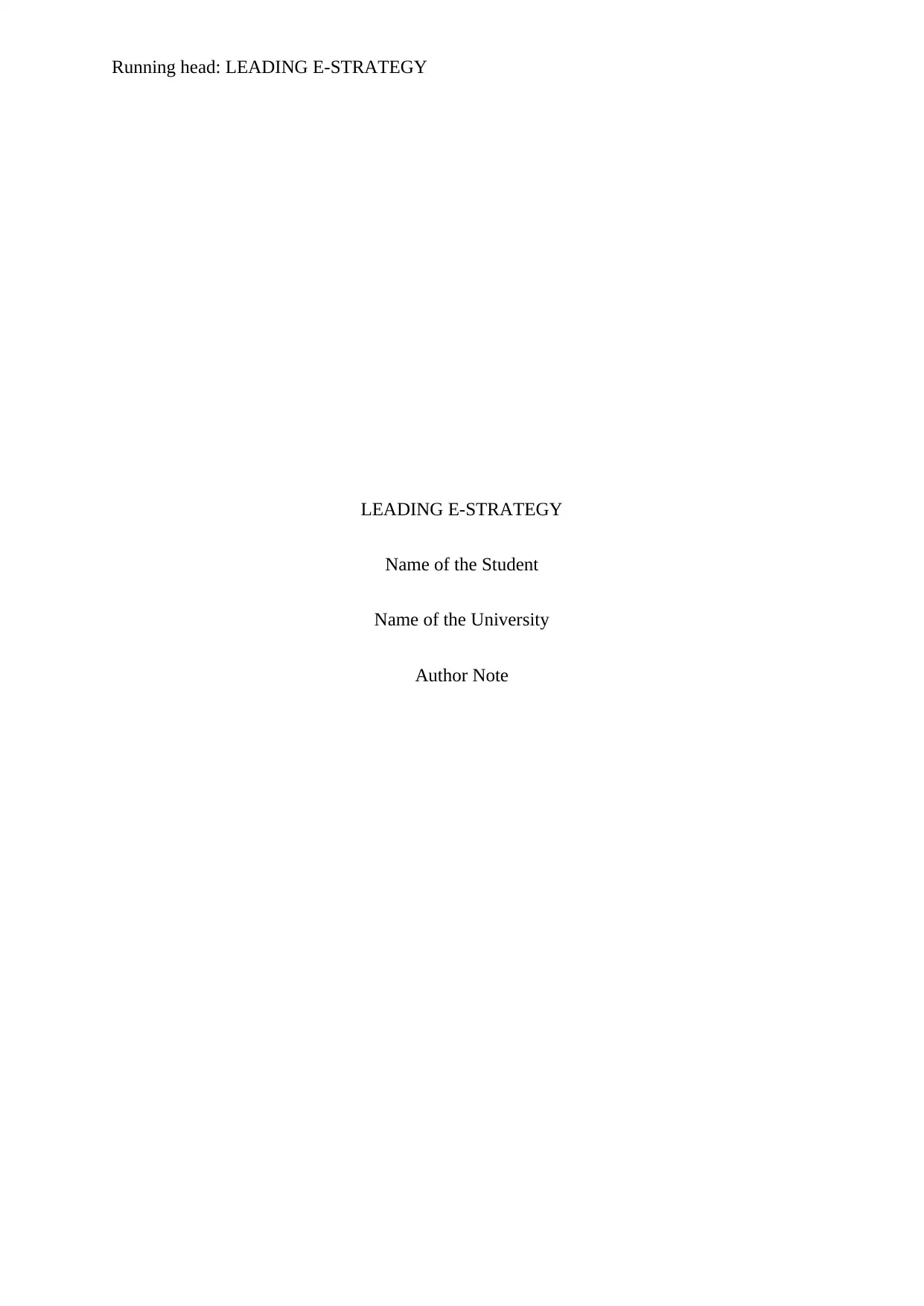
Running head: LEADING E-STRATEGY
LEADING E-STRATEGY
Name of the Student
Name of the University
Author Note
LEADING E-STRATEGY
Name of the Student
Name of the University
Author Note
Paraphrase This Document
Need a fresh take? Get an instant paraphrase of this document with our AI Paraphraser
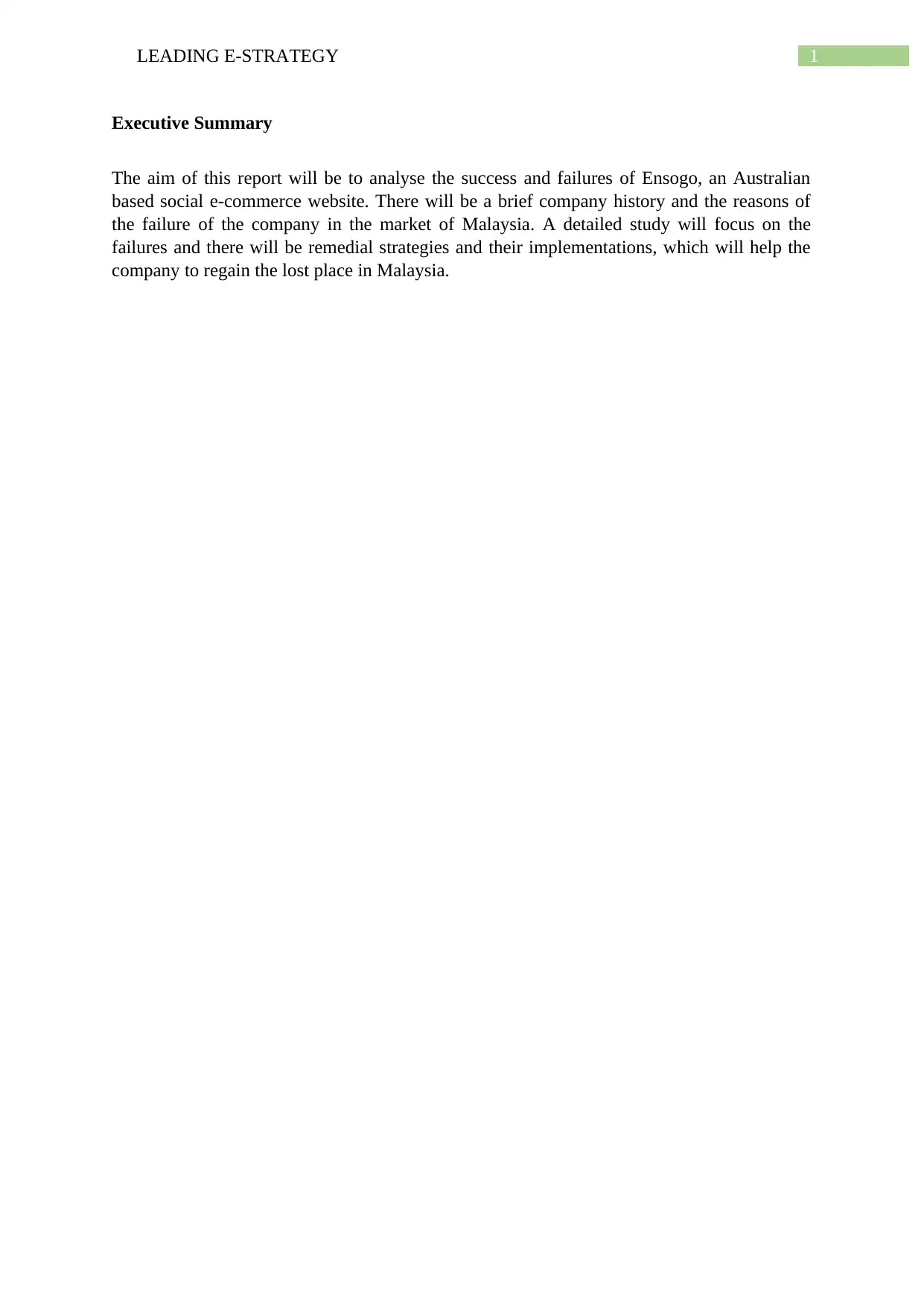
1LEADING E-STRATEGY
Executive Summary
The aim of this report will be to analyse the success and failures of Ensogo, an Australian
based social e-commerce website. There will be a brief company history and the reasons of
the failure of the company in the market of Malaysia. A detailed study will focus on the
failures and there will be remedial strategies and their implementations, which will help the
company to regain the lost place in Malaysia.
Executive Summary
The aim of this report will be to analyse the success and failures of Ensogo, an Australian
based social e-commerce website. There will be a brief company history and the reasons of
the failure of the company in the market of Malaysia. A detailed study will focus on the
failures and there will be remedial strategies and their implementations, which will help the
company to regain the lost place in Malaysia.
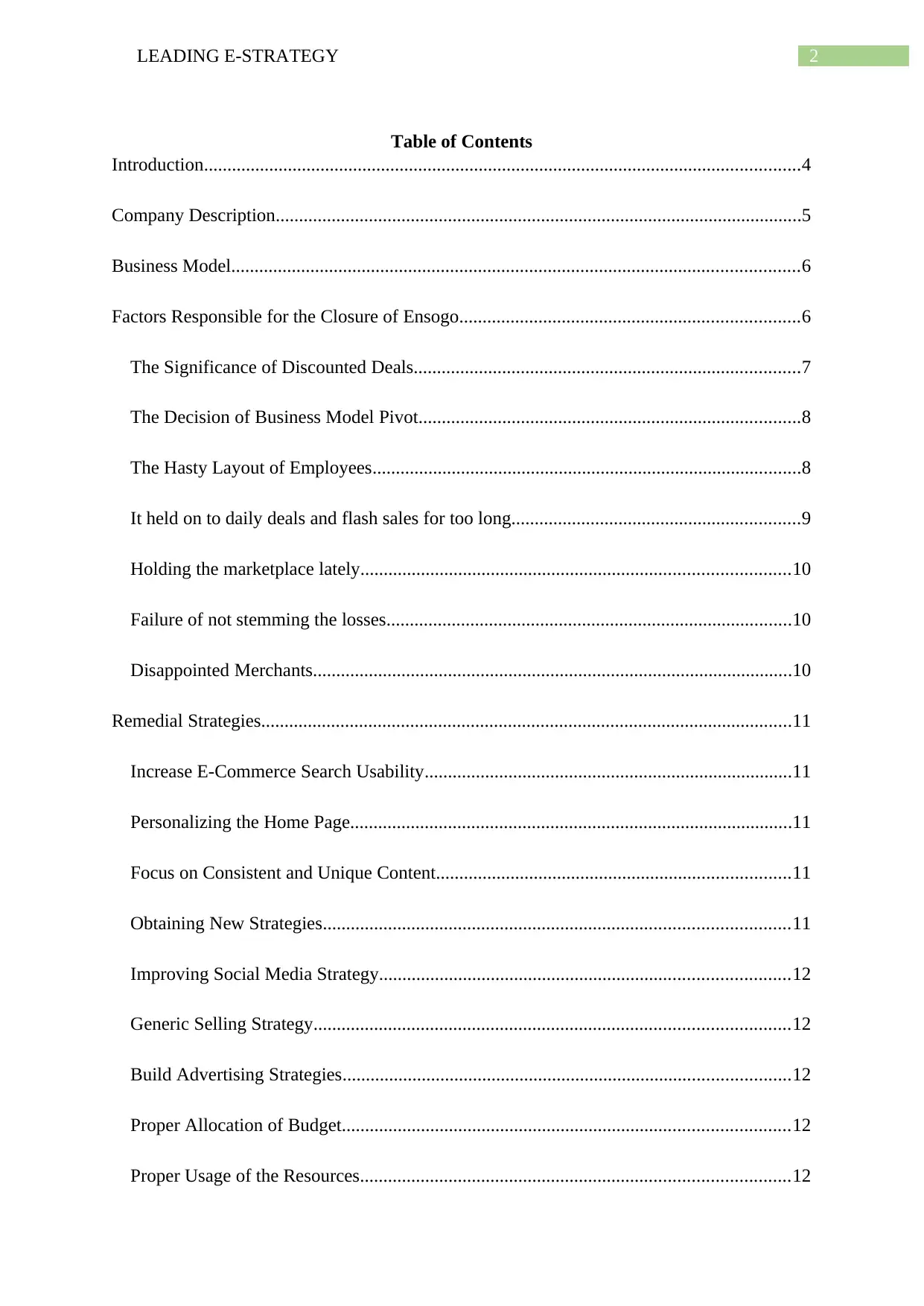
2LEADING E-STRATEGY
Table of Contents
Introduction................................................................................................................................4
Company Description.................................................................................................................5
Business Model..........................................................................................................................6
Factors Responsible for the Closure of Ensogo.........................................................................6
The Significance of Discounted Deals...................................................................................7
The Decision of Business Model Pivot..................................................................................8
The Hasty Layout of Employees............................................................................................8
It held on to daily deals and flash sales for too long..............................................................9
Holding the marketplace lately............................................................................................10
Failure of not stemming the losses.......................................................................................10
Disappointed Merchants.......................................................................................................10
Remedial Strategies..................................................................................................................11
Increase E-Commerce Search Usability...............................................................................11
Personalizing the Home Page...............................................................................................11
Focus on Consistent and Unique Content............................................................................11
Obtaining New Strategies....................................................................................................11
Improving Social Media Strategy........................................................................................12
Generic Selling Strategy......................................................................................................12
Build Advertising Strategies................................................................................................12
Proper Allocation of Budget................................................................................................12
Proper Usage of the Resources............................................................................................12
Table of Contents
Introduction................................................................................................................................4
Company Description.................................................................................................................5
Business Model..........................................................................................................................6
Factors Responsible for the Closure of Ensogo.........................................................................6
The Significance of Discounted Deals...................................................................................7
The Decision of Business Model Pivot..................................................................................8
The Hasty Layout of Employees............................................................................................8
It held on to daily deals and flash sales for too long..............................................................9
Holding the marketplace lately............................................................................................10
Failure of not stemming the losses.......................................................................................10
Disappointed Merchants.......................................................................................................10
Remedial Strategies..................................................................................................................11
Increase E-Commerce Search Usability...............................................................................11
Personalizing the Home Page...............................................................................................11
Focus on Consistent and Unique Content............................................................................11
Obtaining New Strategies....................................................................................................11
Improving Social Media Strategy........................................................................................12
Generic Selling Strategy......................................................................................................12
Build Advertising Strategies................................................................................................12
Proper Allocation of Budget................................................................................................12
Proper Usage of the Resources............................................................................................12
⊘ This is a preview!⊘
Do you want full access?
Subscribe today to unlock all pages.

Trusted by 1+ million students worldwide
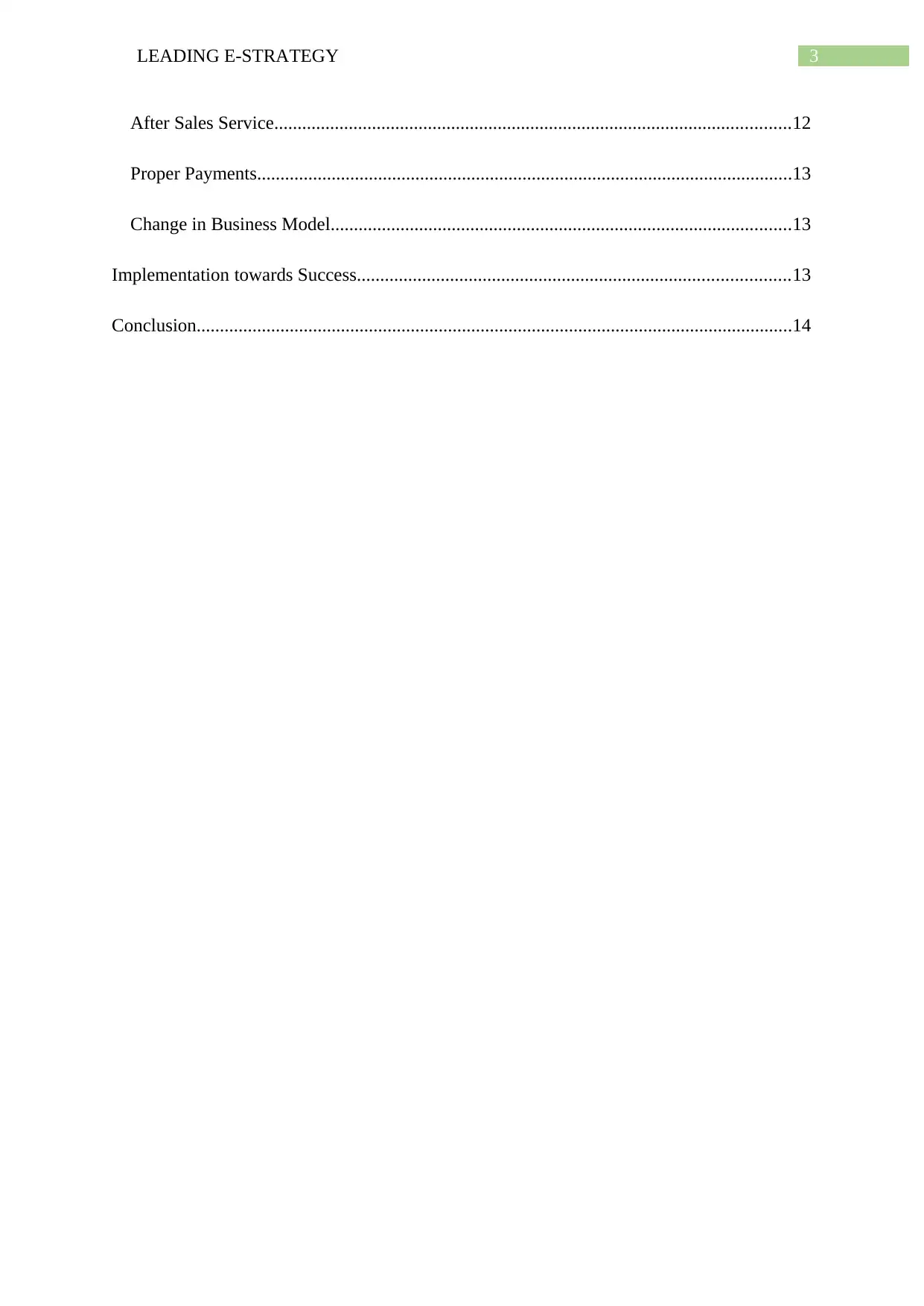
3LEADING E-STRATEGY
After Sales Service...............................................................................................................12
Proper Payments...................................................................................................................13
Change in Business Model...................................................................................................13
Implementation towards Success.............................................................................................13
Conclusion................................................................................................................................14
After Sales Service...............................................................................................................12
Proper Payments...................................................................................................................13
Change in Business Model...................................................................................................13
Implementation towards Success.............................................................................................13
Conclusion................................................................................................................................14
Paraphrase This Document
Need a fresh take? Get an instant paraphrase of this document with our AI Paraphraser
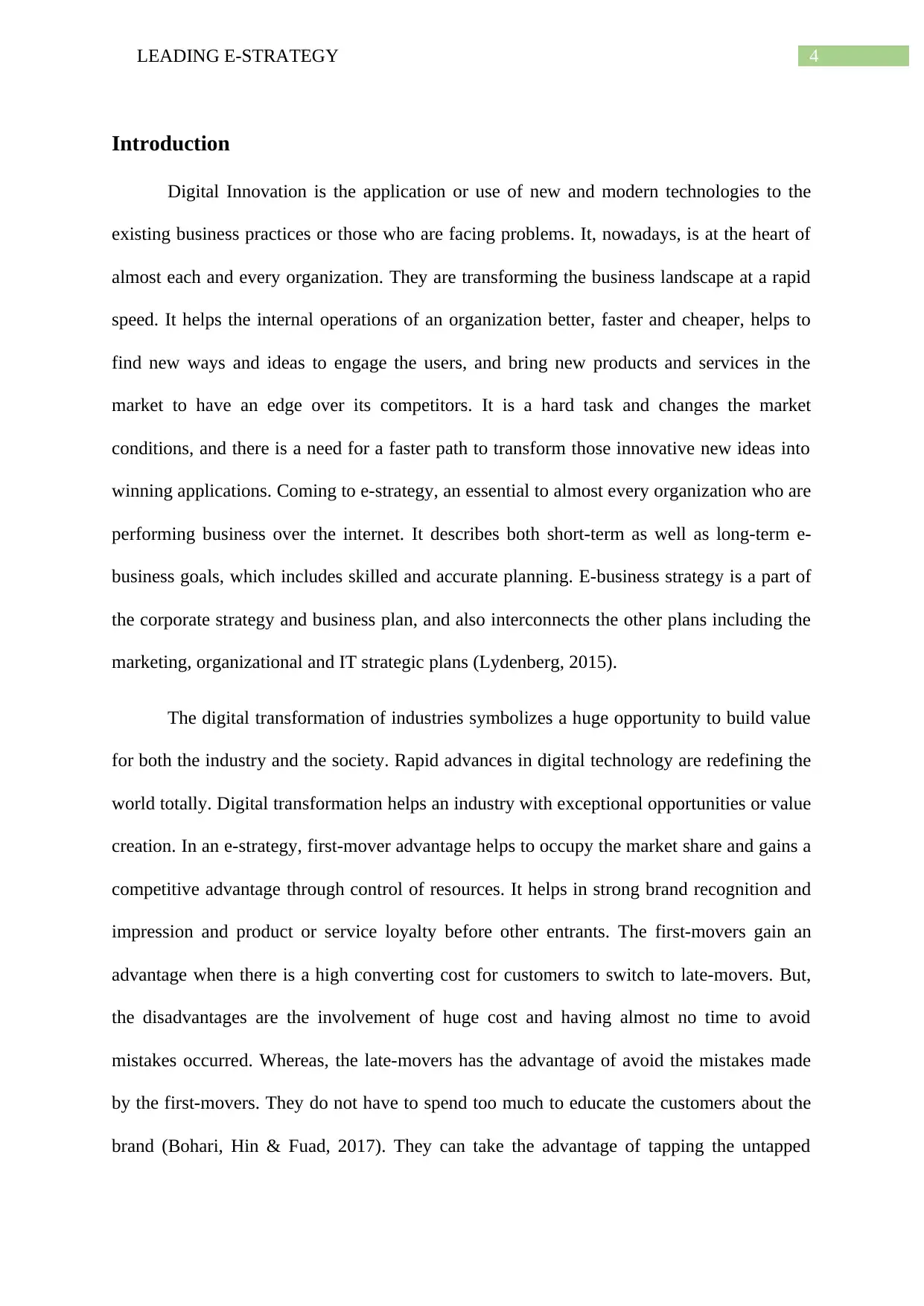
4LEADING E-STRATEGY
Introduction
Digital Innovation is the application or use of new and modern technologies to the
existing business practices or those who are facing problems. It, nowadays, is at the heart of
almost each and every organization. They are transforming the business landscape at a rapid
speed. It helps the internal operations of an organization better, faster and cheaper, helps to
find new ways and ideas to engage the users, and bring new products and services in the
market to have an edge over its competitors. It is a hard task and changes the market
conditions, and there is a need for a faster path to transform those innovative new ideas into
winning applications. Coming to e-strategy, an essential to almost every organization who are
performing business over the internet. It describes both short-term as well as long-term e-
business goals, which includes skilled and accurate planning. E-business strategy is a part of
the corporate strategy and business plan, and also interconnects the other plans including the
marketing, organizational and IT strategic plans (Lydenberg, 2015).
The digital transformation of industries symbolizes a huge opportunity to build value
for both the industry and the society. Rapid advances in digital technology are redefining the
world totally. Digital transformation helps an industry with exceptional opportunities or value
creation. In an e-strategy, first-mover advantage helps to occupy the market share and gains a
competitive advantage through control of resources. It helps in strong brand recognition and
impression and product or service loyalty before other entrants. The first-movers gain an
advantage when there is a high converting cost for customers to switch to late-movers. But,
the disadvantages are the involvement of huge cost and having almost no time to avoid
mistakes occurred. Whereas, the late-movers has the advantage of avoid the mistakes made
by the first-movers. They do not have to spend too much to educate the customers about the
brand (Bohari, Hin & Fuad, 2017). They can take the advantage of tapping the untapped
Introduction
Digital Innovation is the application or use of new and modern technologies to the
existing business practices or those who are facing problems. It, nowadays, is at the heart of
almost each and every organization. They are transforming the business landscape at a rapid
speed. It helps the internal operations of an organization better, faster and cheaper, helps to
find new ways and ideas to engage the users, and bring new products and services in the
market to have an edge over its competitors. It is a hard task and changes the market
conditions, and there is a need for a faster path to transform those innovative new ideas into
winning applications. Coming to e-strategy, an essential to almost every organization who are
performing business over the internet. It describes both short-term as well as long-term e-
business goals, which includes skilled and accurate planning. E-business strategy is a part of
the corporate strategy and business plan, and also interconnects the other plans including the
marketing, organizational and IT strategic plans (Lydenberg, 2015).
The digital transformation of industries symbolizes a huge opportunity to build value
for both the industry and the society. Rapid advances in digital technology are redefining the
world totally. Digital transformation helps an industry with exceptional opportunities or value
creation. In an e-strategy, first-mover advantage helps to occupy the market share and gains a
competitive advantage through control of resources. It helps in strong brand recognition and
impression and product or service loyalty before other entrants. The first-movers gain an
advantage when there is a high converting cost for customers to switch to late-movers. But,
the disadvantages are the involvement of huge cost and having almost no time to avoid
mistakes occurred. Whereas, the late-movers has the advantage of avoid the mistakes made
by the first-movers. They do not have to spend too much to educate the customers about the
brand (Bohari, Hin & Fuad, 2017). They can take the advantage of tapping the untapped
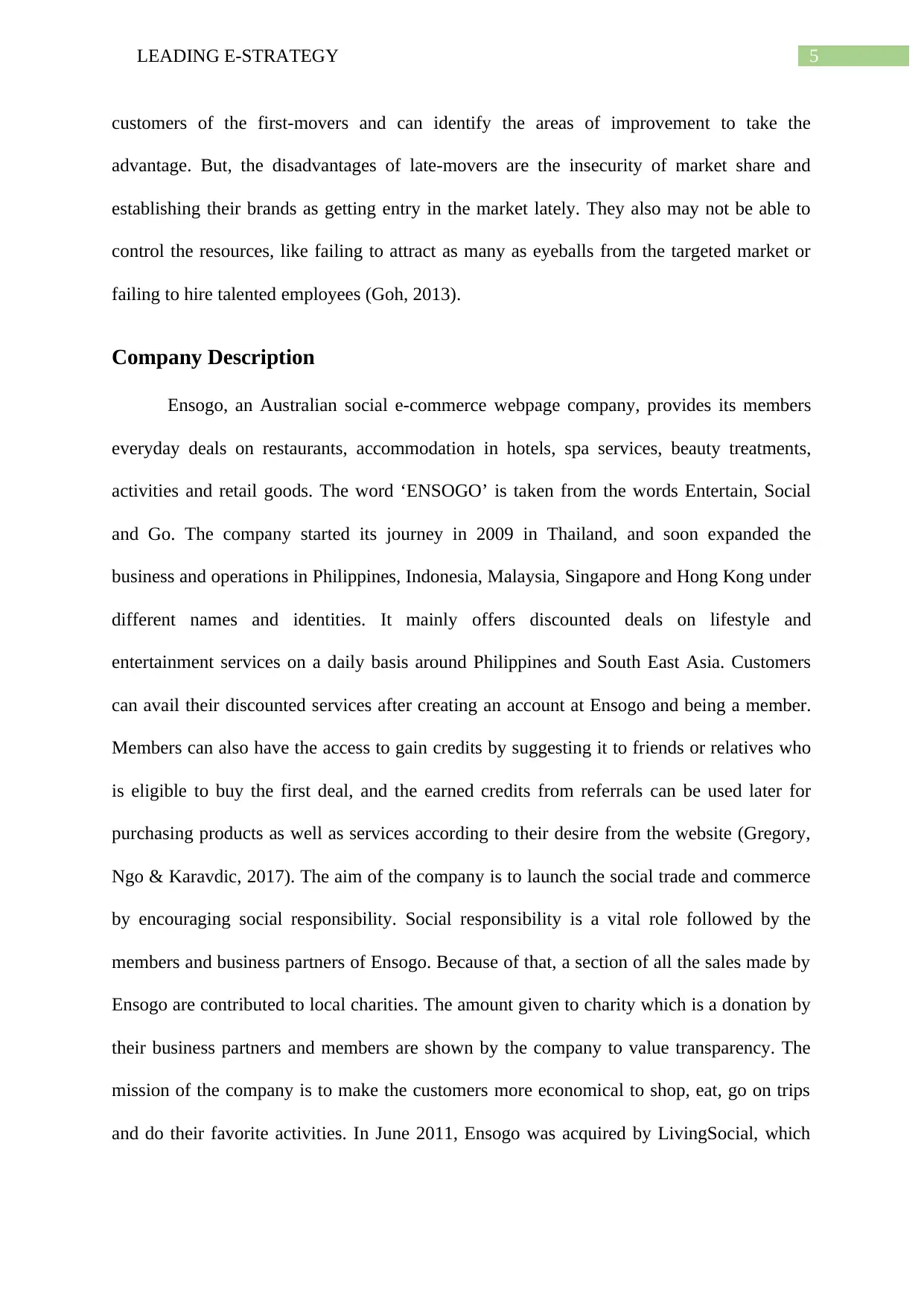
5LEADING E-STRATEGY
customers of the first-movers and can identify the areas of improvement to take the
advantage. But, the disadvantages of late-movers are the insecurity of market share and
establishing their brands as getting entry in the market lately. They also may not be able to
control the resources, like failing to attract as many as eyeballs from the targeted market or
failing to hire talented employees (Goh, 2013).
Company Description
Ensogo, an Australian social e-commerce webpage company, provides its members
everyday deals on restaurants, accommodation in hotels, spa services, beauty treatments,
activities and retail goods. The word ‘ENSOGO’ is taken from the words Entertain, Social
and Go. The company started its journey in 2009 in Thailand, and soon expanded the
business and operations in Philippines, Indonesia, Malaysia, Singapore and Hong Kong under
different names and identities. It mainly offers discounted deals on lifestyle and
entertainment services on a daily basis around Philippines and South East Asia. Customers
can avail their discounted services after creating an account at Ensogo and being a member.
Members can also have the access to gain credits by suggesting it to friends or relatives who
is eligible to buy the first deal, and the earned credits from referrals can be used later for
purchasing products as well as services according to their desire from the website (Gregory,
Ngo & Karavdic, 2017). The aim of the company is to launch the social trade and commerce
by encouraging social responsibility. Social responsibility is a vital role followed by the
members and business partners of Ensogo. Because of that, a section of all the sales made by
Ensogo are contributed to local charities. The amount given to charity which is a donation by
their business partners and members are shown by the company to value transparency. The
mission of the company is to make the customers more economical to shop, eat, go on trips
and do their favorite activities. In June 2011, Ensogo was acquired by LivingSocial, which
customers of the first-movers and can identify the areas of improvement to take the
advantage. But, the disadvantages of late-movers are the insecurity of market share and
establishing their brands as getting entry in the market lately. They also may not be able to
control the resources, like failing to attract as many as eyeballs from the targeted market or
failing to hire talented employees (Goh, 2013).
Company Description
Ensogo, an Australian social e-commerce webpage company, provides its members
everyday deals on restaurants, accommodation in hotels, spa services, beauty treatments,
activities and retail goods. The word ‘ENSOGO’ is taken from the words Entertain, Social
and Go. The company started its journey in 2009 in Thailand, and soon expanded the
business and operations in Philippines, Indonesia, Malaysia, Singapore and Hong Kong under
different names and identities. It mainly offers discounted deals on lifestyle and
entertainment services on a daily basis around Philippines and South East Asia. Customers
can avail their discounted services after creating an account at Ensogo and being a member.
Members can also have the access to gain credits by suggesting it to friends or relatives who
is eligible to buy the first deal, and the earned credits from referrals can be used later for
purchasing products as well as services according to their desire from the website (Gregory,
Ngo & Karavdic, 2017). The aim of the company is to launch the social trade and commerce
by encouraging social responsibility. Social responsibility is a vital role followed by the
members and business partners of Ensogo. Because of that, a section of all the sales made by
Ensogo are contributed to local charities. The amount given to charity which is a donation by
their business partners and members are shown by the company to value transparency. The
mission of the company is to make the customers more economical to shop, eat, go on trips
and do their favorite activities. In June 2011, Ensogo was acquired by LivingSocial, which
⊘ This is a preview!⊘
Do you want full access?
Subscribe today to unlock all pages.

Trusted by 1+ million students worldwide
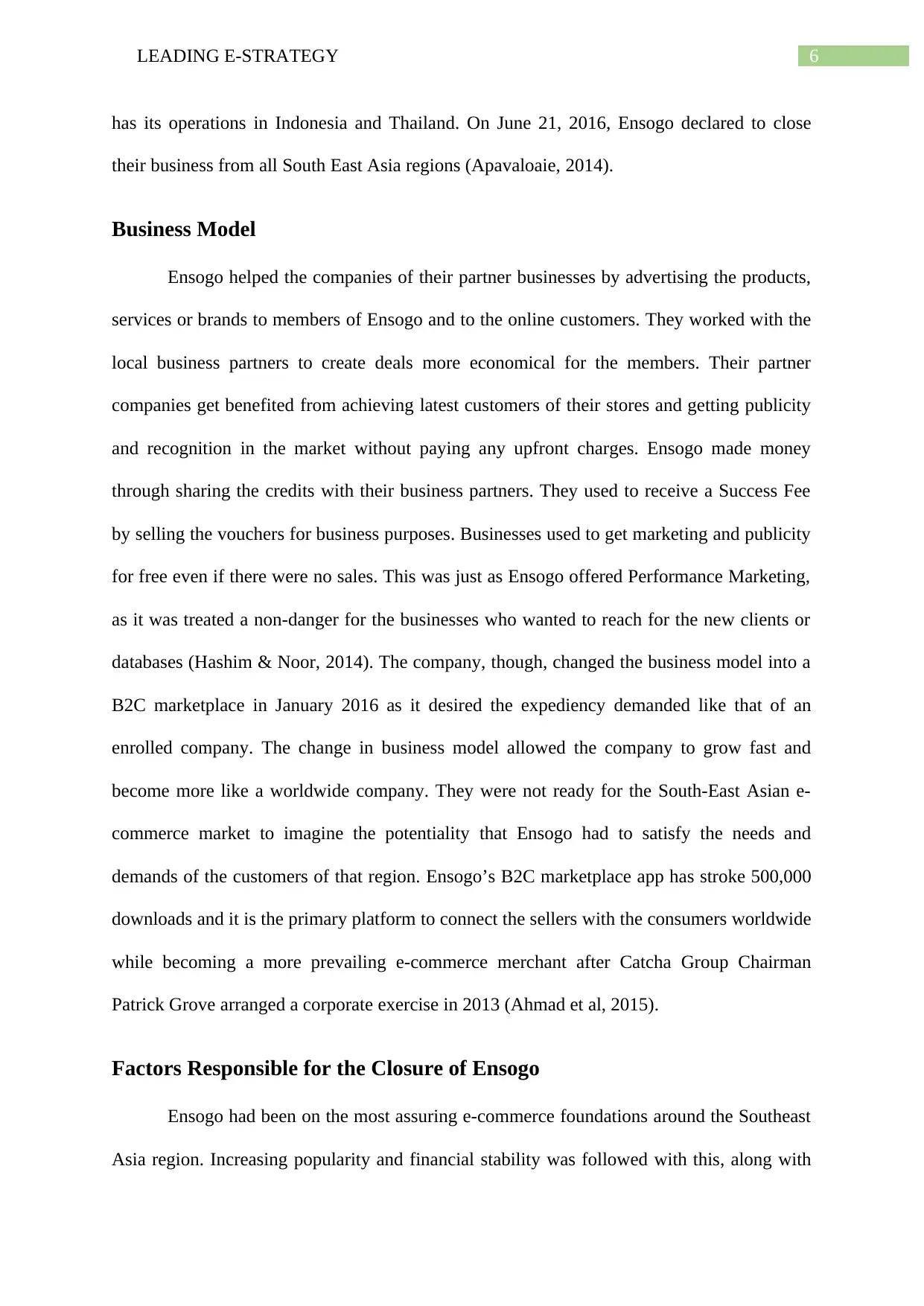
6LEADING E-STRATEGY
has its operations in Indonesia and Thailand. On June 21, 2016, Ensogo declared to close
their business from all South East Asia regions (Apavaloaie, 2014).
Business Model
Ensogo helped the companies of their partner businesses by advertising the products,
services or brands to members of Ensogo and to the online customers. They worked with the
local business partners to create deals more economical for the members. Their partner
companies get benefited from achieving latest customers of their stores and getting publicity
and recognition in the market without paying any upfront charges. Ensogo made money
through sharing the credits with their business partners. They used to receive a Success Fee
by selling the vouchers for business purposes. Businesses used to get marketing and publicity
for free even if there were no sales. This was just as Ensogo offered Performance Marketing,
as it was treated a non-danger for the businesses who wanted to reach for the new clients or
databases (Hashim & Noor, 2014). The company, though, changed the business model into a
B2C marketplace in January 2016 as it desired the expediency demanded like that of an
enrolled company. The change in business model allowed the company to grow fast and
become more like a worldwide company. They were not ready for the South-East Asian e-
commerce market to imagine the potentiality that Ensogo had to satisfy the needs and
demands of the customers of that region. Ensogo’s B2C marketplace app has stroke 500,000
downloads and it is the primary platform to connect the sellers with the consumers worldwide
while becoming a more prevailing e-commerce merchant after Catcha Group Chairman
Patrick Grove arranged a corporate exercise in 2013 (Ahmad et al, 2015).
Factors Responsible for the Closure of Ensogo
Ensogo had been on the most assuring e-commerce foundations around the Southeast
Asia region. Increasing popularity and financial stability was followed with this, along with
has its operations in Indonesia and Thailand. On June 21, 2016, Ensogo declared to close
their business from all South East Asia regions (Apavaloaie, 2014).
Business Model
Ensogo helped the companies of their partner businesses by advertising the products,
services or brands to members of Ensogo and to the online customers. They worked with the
local business partners to create deals more economical for the members. Their partner
companies get benefited from achieving latest customers of their stores and getting publicity
and recognition in the market without paying any upfront charges. Ensogo made money
through sharing the credits with their business partners. They used to receive a Success Fee
by selling the vouchers for business purposes. Businesses used to get marketing and publicity
for free even if there were no sales. This was just as Ensogo offered Performance Marketing,
as it was treated a non-danger for the businesses who wanted to reach for the new clients or
databases (Hashim & Noor, 2014). The company, though, changed the business model into a
B2C marketplace in January 2016 as it desired the expediency demanded like that of an
enrolled company. The change in business model allowed the company to grow fast and
become more like a worldwide company. They were not ready for the South-East Asian e-
commerce market to imagine the potentiality that Ensogo had to satisfy the needs and
demands of the customers of that region. Ensogo’s B2C marketplace app has stroke 500,000
downloads and it is the primary platform to connect the sellers with the consumers worldwide
while becoming a more prevailing e-commerce merchant after Catcha Group Chairman
Patrick Grove arranged a corporate exercise in 2013 (Ahmad et al, 2015).
Factors Responsible for the Closure of Ensogo
Ensogo had been on the most assuring e-commerce foundations around the Southeast
Asia region. Increasing popularity and financial stability was followed with this, along with
Paraphrase This Document
Need a fresh take? Get an instant paraphrase of this document with our AI Paraphraser
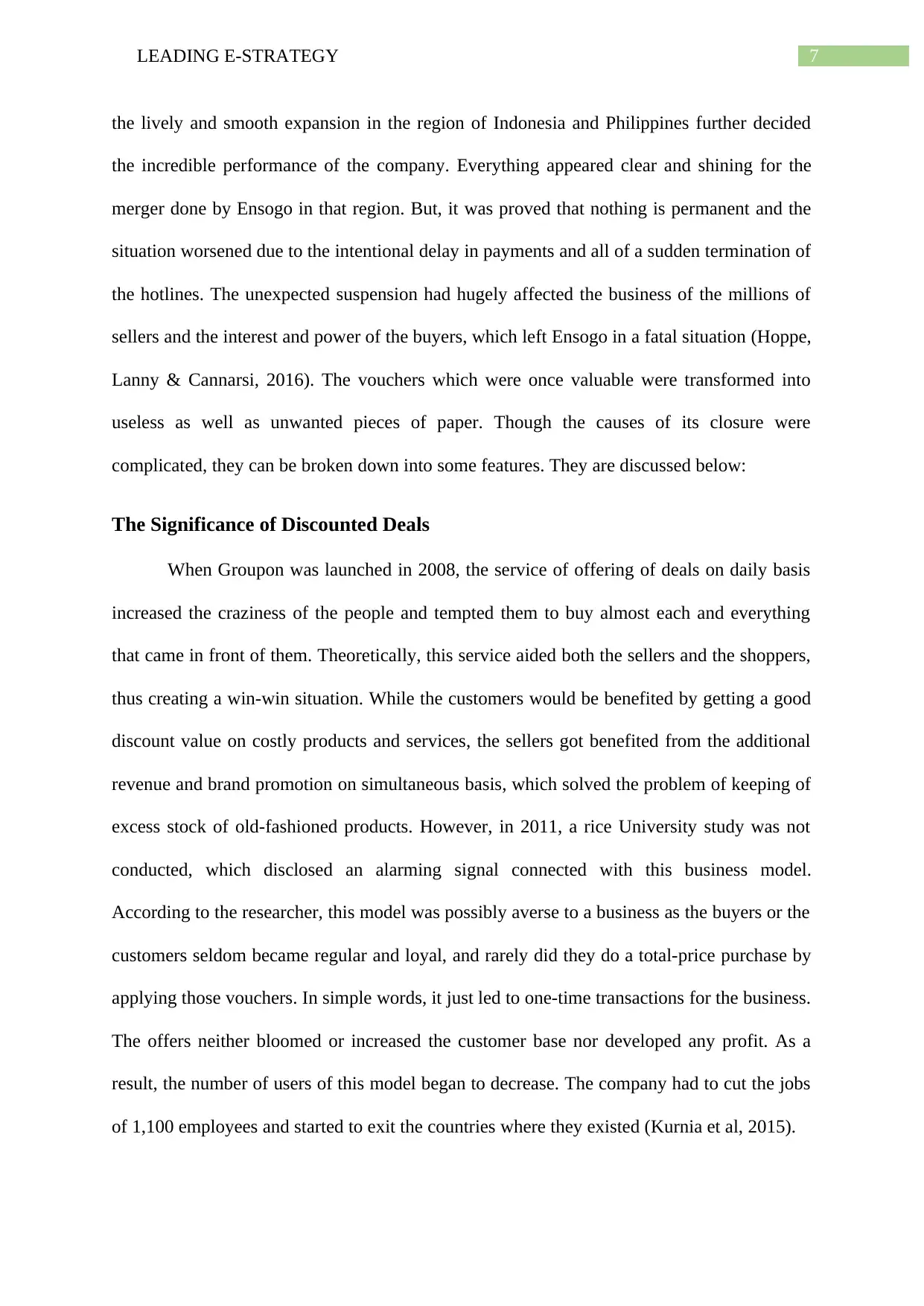
7LEADING E-STRATEGY
the lively and smooth expansion in the region of Indonesia and Philippines further decided
the incredible performance of the company. Everything appeared clear and shining for the
merger done by Ensogo in that region. But, it was proved that nothing is permanent and the
situation worsened due to the intentional delay in payments and all of a sudden termination of
the hotlines. The unexpected suspension had hugely affected the business of the millions of
sellers and the interest and power of the buyers, which left Ensogo in a fatal situation (Hoppe,
Lanny & Cannarsi, 2016). The vouchers which were once valuable were transformed into
useless as well as unwanted pieces of paper. Though the causes of its closure were
complicated, they can be broken down into some features. They are discussed below:
The Significance of Discounted Deals
When Groupon was launched in 2008, the service of offering of deals on daily basis
increased the craziness of the people and tempted them to buy almost each and everything
that came in front of them. Theoretically, this service aided both the sellers and the shoppers,
thus creating a win-win situation. While the customers would be benefited by getting a good
discount value on costly products and services, the sellers got benefited from the additional
revenue and brand promotion on simultaneous basis, which solved the problem of keeping of
excess stock of old-fashioned products. However, in 2011, a rice University study was not
conducted, which disclosed an alarming signal connected with this business model.
According to the researcher, this model was possibly averse to a business as the buyers or the
customers seldom became regular and loyal, and rarely did they do a total-price purchase by
applying those vouchers. In simple words, it just led to one-time transactions for the business.
The offers neither bloomed or increased the customer base nor developed any profit. As a
result, the number of users of this model began to decrease. The company had to cut the jobs
of 1,100 employees and started to exit the countries where they existed (Kurnia et al, 2015).
the lively and smooth expansion in the region of Indonesia and Philippines further decided
the incredible performance of the company. Everything appeared clear and shining for the
merger done by Ensogo in that region. But, it was proved that nothing is permanent and the
situation worsened due to the intentional delay in payments and all of a sudden termination of
the hotlines. The unexpected suspension had hugely affected the business of the millions of
sellers and the interest and power of the buyers, which left Ensogo in a fatal situation (Hoppe,
Lanny & Cannarsi, 2016). The vouchers which were once valuable were transformed into
useless as well as unwanted pieces of paper. Though the causes of its closure were
complicated, they can be broken down into some features. They are discussed below:
The Significance of Discounted Deals
When Groupon was launched in 2008, the service of offering of deals on daily basis
increased the craziness of the people and tempted them to buy almost each and everything
that came in front of them. Theoretically, this service aided both the sellers and the shoppers,
thus creating a win-win situation. While the customers would be benefited by getting a good
discount value on costly products and services, the sellers got benefited from the additional
revenue and brand promotion on simultaneous basis, which solved the problem of keeping of
excess stock of old-fashioned products. However, in 2011, a rice University study was not
conducted, which disclosed an alarming signal connected with this business model.
According to the researcher, this model was possibly averse to a business as the buyers or the
customers seldom became regular and loyal, and rarely did they do a total-price purchase by
applying those vouchers. In simple words, it just led to one-time transactions for the business.
The offers neither bloomed or increased the customer base nor developed any profit. As a
result, the number of users of this model began to decrease. The company had to cut the jobs
of 1,100 employees and started to exit the countries where they existed (Kurnia et al, 2015).
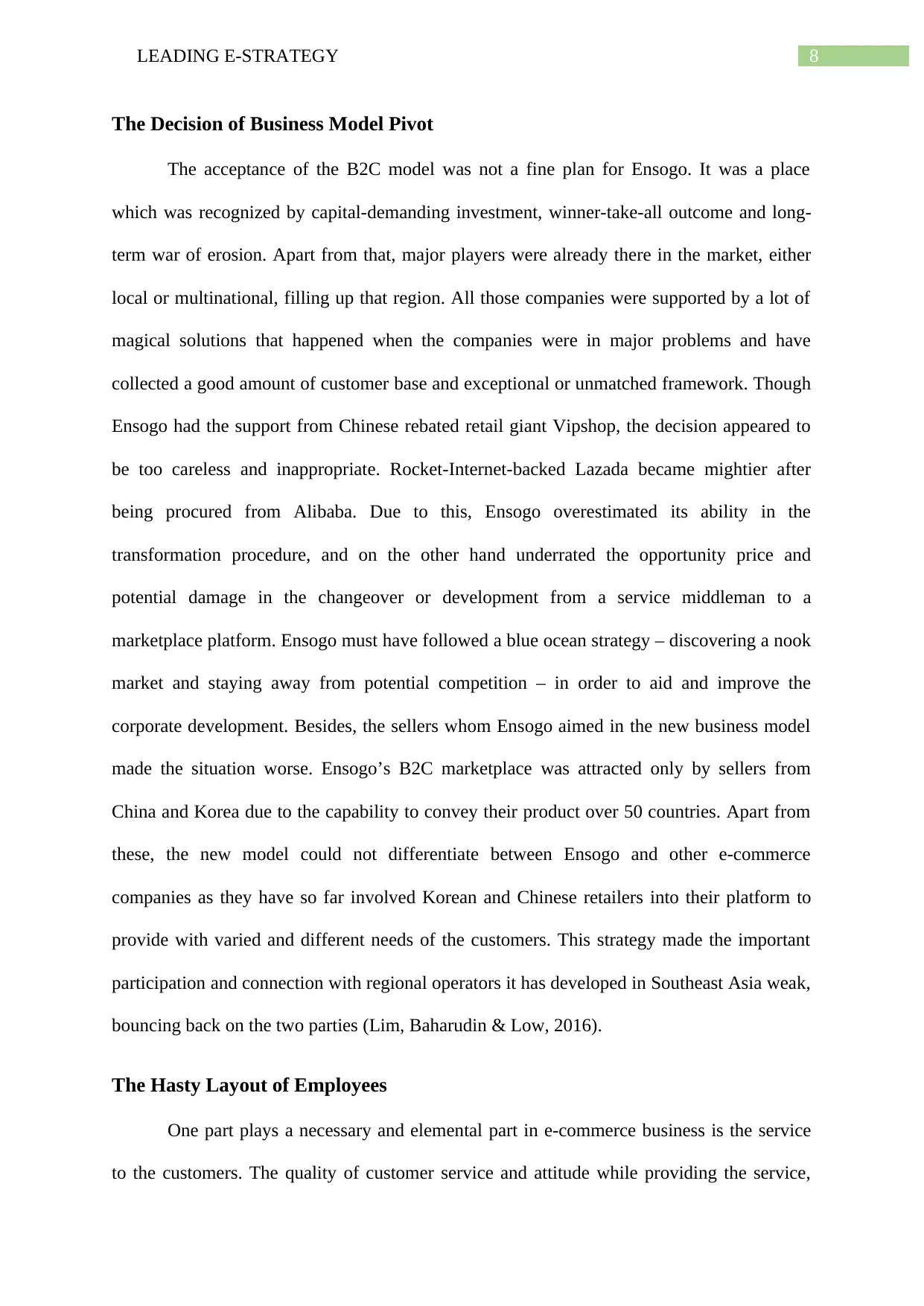
8LEADING E-STRATEGY
The Decision of Business Model Pivot
The acceptance of the B2C model was not a fine plan for Ensogo. It was a place
which was recognized by capital-demanding investment, winner-take-all outcome and long-
term war of erosion. Apart from that, major players were already there in the market, either
local or multinational, filling up that region. All those companies were supported by a lot of
magical solutions that happened when the companies were in major problems and have
collected a good amount of customer base and exceptional or unmatched framework. Though
Ensogo had the support from Chinese rebated retail giant Vipshop, the decision appeared to
be too careless and inappropriate. Rocket-Internet-backed Lazada became mightier after
being procured from Alibaba. Due to this, Ensogo overestimated its ability in the
transformation procedure, and on the other hand underrated the opportunity price and
potential damage in the changeover or development from a service middleman to a
marketplace platform. Ensogo must have followed a blue ocean strategy – discovering a nook
market and staying away from potential competition – in order to aid and improve the
corporate development. Besides, the sellers whom Ensogo aimed in the new business model
made the situation worse. Ensogo’s B2C marketplace was attracted only by sellers from
China and Korea due to the capability to convey their product over 50 countries. Apart from
these, the new model could not differentiate between Ensogo and other e-commerce
companies as they have so far involved Korean and Chinese retailers into their platform to
provide with varied and different needs of the customers. This strategy made the important
participation and connection with regional operators it has developed in Southeast Asia weak,
bouncing back on the two parties (Lim, Baharudin & Low, 2016).
The Hasty Layout of Employees
One part plays a necessary and elemental part in e-commerce business is the service
to the customers. The quality of customer service and attitude while providing the service,
The Decision of Business Model Pivot
The acceptance of the B2C model was not a fine plan for Ensogo. It was a place
which was recognized by capital-demanding investment, winner-take-all outcome and long-
term war of erosion. Apart from that, major players were already there in the market, either
local or multinational, filling up that region. All those companies were supported by a lot of
magical solutions that happened when the companies were in major problems and have
collected a good amount of customer base and exceptional or unmatched framework. Though
Ensogo had the support from Chinese rebated retail giant Vipshop, the decision appeared to
be too careless and inappropriate. Rocket-Internet-backed Lazada became mightier after
being procured from Alibaba. Due to this, Ensogo overestimated its ability in the
transformation procedure, and on the other hand underrated the opportunity price and
potential damage in the changeover or development from a service middleman to a
marketplace platform. Ensogo must have followed a blue ocean strategy – discovering a nook
market and staying away from potential competition – in order to aid and improve the
corporate development. Besides, the sellers whom Ensogo aimed in the new business model
made the situation worse. Ensogo’s B2C marketplace was attracted only by sellers from
China and Korea due to the capability to convey their product over 50 countries. Apart from
these, the new model could not differentiate between Ensogo and other e-commerce
companies as they have so far involved Korean and Chinese retailers into their platform to
provide with varied and different needs of the customers. This strategy made the important
participation and connection with regional operators it has developed in Southeast Asia weak,
bouncing back on the two parties (Lim, Baharudin & Low, 2016).
The Hasty Layout of Employees
One part plays a necessary and elemental part in e-commerce business is the service
to the customers. The quality of customer service and attitude while providing the service,
⊘ This is a preview!⊘
Do you want full access?
Subscribe today to unlock all pages.

Trusted by 1+ million students worldwide
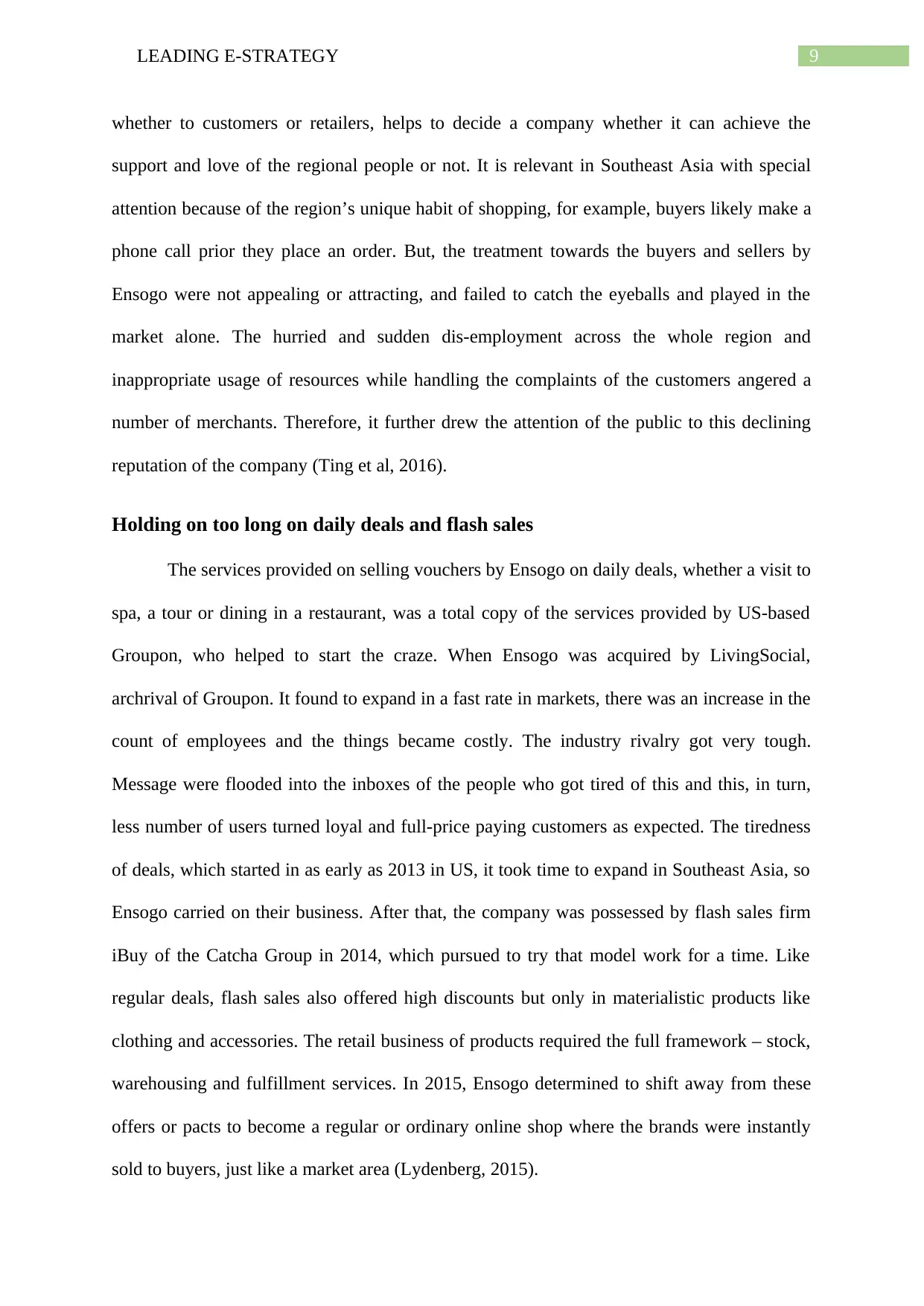
9LEADING E-STRATEGY
whether to customers or retailers, helps to decide a company whether it can achieve the
support and love of the regional people or not. It is relevant in Southeast Asia with special
attention because of the region’s unique habit of shopping, for example, buyers likely make a
phone call prior they place an order. But, the treatment towards the buyers and sellers by
Ensogo were not appealing or attracting, and failed to catch the eyeballs and played in the
market alone. The hurried and sudden dis-employment across the whole region and
inappropriate usage of resources while handling the complaints of the customers angered a
number of merchants. Therefore, it further drew the attention of the public to this declining
reputation of the company (Ting et al, 2016).
Holding on too long on daily deals and flash sales
The services provided on selling vouchers by Ensogo on daily deals, whether a visit to
spa, a tour or dining in a restaurant, was a total copy of the services provided by US-based
Groupon, who helped to start the craze. When Ensogo was acquired by LivingSocial,
archrival of Groupon. It found to expand in a fast rate in markets, there was an increase in the
count of employees and the things became costly. The industry rivalry got very tough.
Message were flooded into the inboxes of the people who got tired of this and this, in turn,
less number of users turned loyal and full-price paying customers as expected. The tiredness
of deals, which started in as early as 2013 in US, it took time to expand in Southeast Asia, so
Ensogo carried on their business. After that, the company was possessed by flash sales firm
iBuy of the Catcha Group in 2014, which pursued to try that model work for a time. Like
regular deals, flash sales also offered high discounts but only in materialistic products like
clothing and accessories. The retail business of products required the full framework – stock,
warehousing and fulfillment services. In 2015, Ensogo determined to shift away from these
offers or pacts to become a regular or ordinary online shop where the brands were instantly
sold to buyers, just like a market area (Lydenberg, 2015).
whether to customers or retailers, helps to decide a company whether it can achieve the
support and love of the regional people or not. It is relevant in Southeast Asia with special
attention because of the region’s unique habit of shopping, for example, buyers likely make a
phone call prior they place an order. But, the treatment towards the buyers and sellers by
Ensogo were not appealing or attracting, and failed to catch the eyeballs and played in the
market alone. The hurried and sudden dis-employment across the whole region and
inappropriate usage of resources while handling the complaints of the customers angered a
number of merchants. Therefore, it further drew the attention of the public to this declining
reputation of the company (Ting et al, 2016).
Holding on too long on daily deals and flash sales
The services provided on selling vouchers by Ensogo on daily deals, whether a visit to
spa, a tour or dining in a restaurant, was a total copy of the services provided by US-based
Groupon, who helped to start the craze. When Ensogo was acquired by LivingSocial,
archrival of Groupon. It found to expand in a fast rate in markets, there was an increase in the
count of employees and the things became costly. The industry rivalry got very tough.
Message were flooded into the inboxes of the people who got tired of this and this, in turn,
less number of users turned loyal and full-price paying customers as expected. The tiredness
of deals, which started in as early as 2013 in US, it took time to expand in Southeast Asia, so
Ensogo carried on their business. After that, the company was possessed by flash sales firm
iBuy of the Catcha Group in 2014, which pursued to try that model work for a time. Like
regular deals, flash sales also offered high discounts but only in materialistic products like
clothing and accessories. The retail business of products required the full framework – stock,
warehousing and fulfillment services. In 2015, Ensogo determined to shift away from these
offers or pacts to become a regular or ordinary online shop where the brands were instantly
sold to buyers, just like a market area (Lydenberg, 2015).
Paraphrase This Document
Need a fresh take? Get an instant paraphrase of this document with our AI Paraphraser
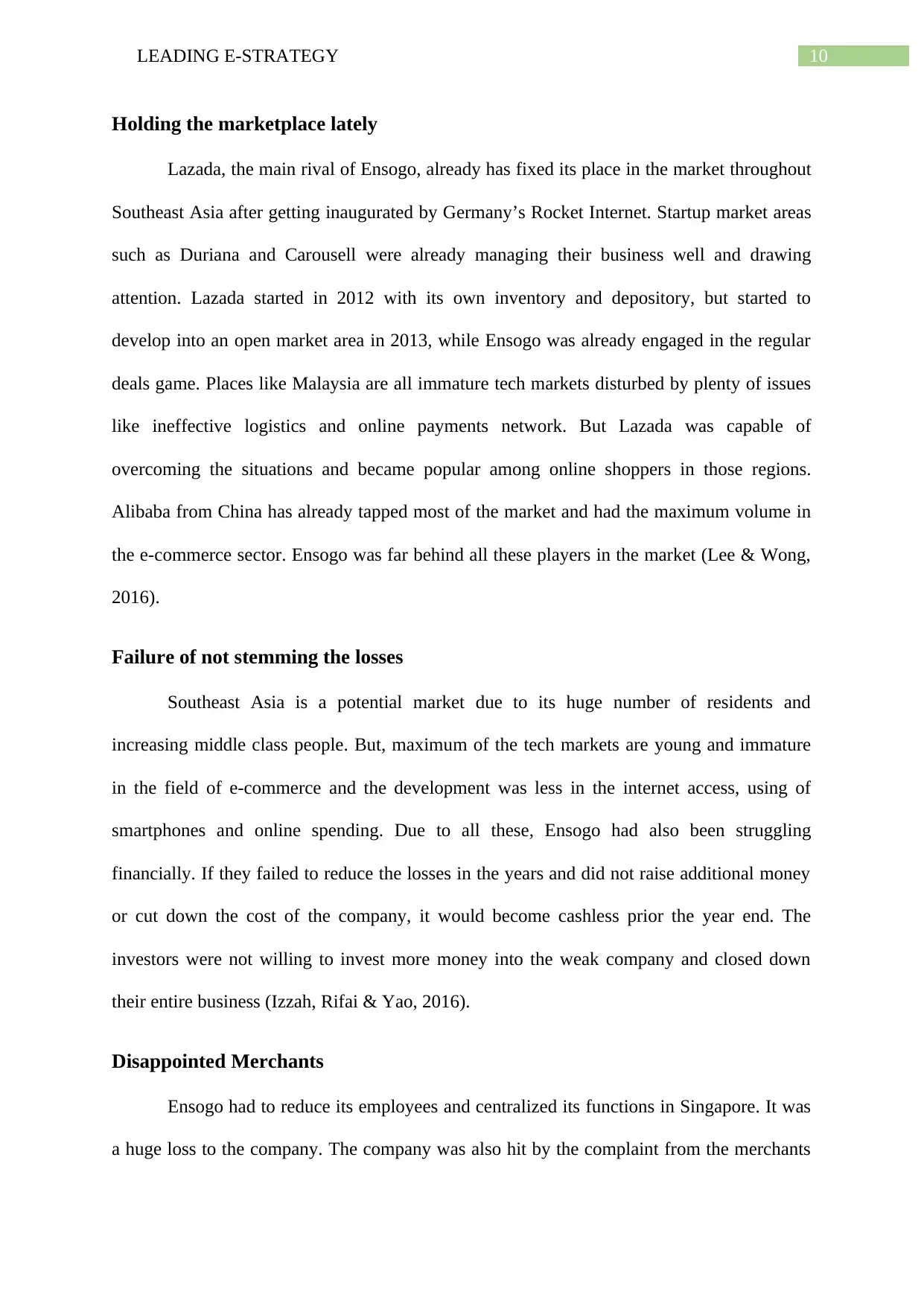
10LEADING E-STRATEGY
Holding the marketplace lately
Lazada, the main rival of Ensogo, already has fixed its place in the market throughout
Southeast Asia after getting inaugurated by Germany’s Rocket Internet. Startup market areas
such as Duriana and Carousell were already managing their business well and drawing
attention. Lazada started in 2012 with its own inventory and depository, but started to
develop into an open market area in 2013, while Ensogo was already engaged in the regular
deals game. Places like Malaysia are all immature tech markets disturbed by plenty of issues
like ineffective logistics and online payments network. But Lazada was capable of
overcoming the situations and became popular among online shoppers in those regions.
Alibaba from China has already tapped most of the market and had the maximum volume in
the e-commerce sector. Ensogo was far behind all these players in the market (Lee & Wong,
2016).
Failure of not stemming the losses
Southeast Asia is a potential market due to its huge number of residents and
increasing middle class people. But, maximum of the tech markets are young and immature
in the field of e-commerce and the development was less in the internet access, using of
smartphones and online spending. Due to all these, Ensogo had also been struggling
financially. If they failed to reduce the losses in the years and did not raise additional money
or cut down the cost of the company, it would become cashless prior the year end. The
investors were not willing to invest more money into the weak company and closed down
their entire business (Izzah, Rifai & Yao, 2016).
Disappointed Merchants
Ensogo had to reduce its employees and centralized its functions in Singapore. It was
a huge loss to the company. The company was also hit by the complaint from the merchants
Holding the marketplace lately
Lazada, the main rival of Ensogo, already has fixed its place in the market throughout
Southeast Asia after getting inaugurated by Germany’s Rocket Internet. Startup market areas
such as Duriana and Carousell were already managing their business well and drawing
attention. Lazada started in 2012 with its own inventory and depository, but started to
develop into an open market area in 2013, while Ensogo was already engaged in the regular
deals game. Places like Malaysia are all immature tech markets disturbed by plenty of issues
like ineffective logistics and online payments network. But Lazada was capable of
overcoming the situations and became popular among online shoppers in those regions.
Alibaba from China has already tapped most of the market and had the maximum volume in
the e-commerce sector. Ensogo was far behind all these players in the market (Lee & Wong,
2016).
Failure of not stemming the losses
Southeast Asia is a potential market due to its huge number of residents and
increasing middle class people. But, maximum of the tech markets are young and immature
in the field of e-commerce and the development was less in the internet access, using of
smartphones and online spending. Due to all these, Ensogo had also been struggling
financially. If they failed to reduce the losses in the years and did not raise additional money
or cut down the cost of the company, it would become cashless prior the year end. The
investors were not willing to invest more money into the weak company and closed down
their entire business (Izzah, Rifai & Yao, 2016).
Disappointed Merchants
Ensogo had to reduce its employees and centralized its functions in Singapore. It was
a huge loss to the company. The company was also hit by the complaint from the merchants
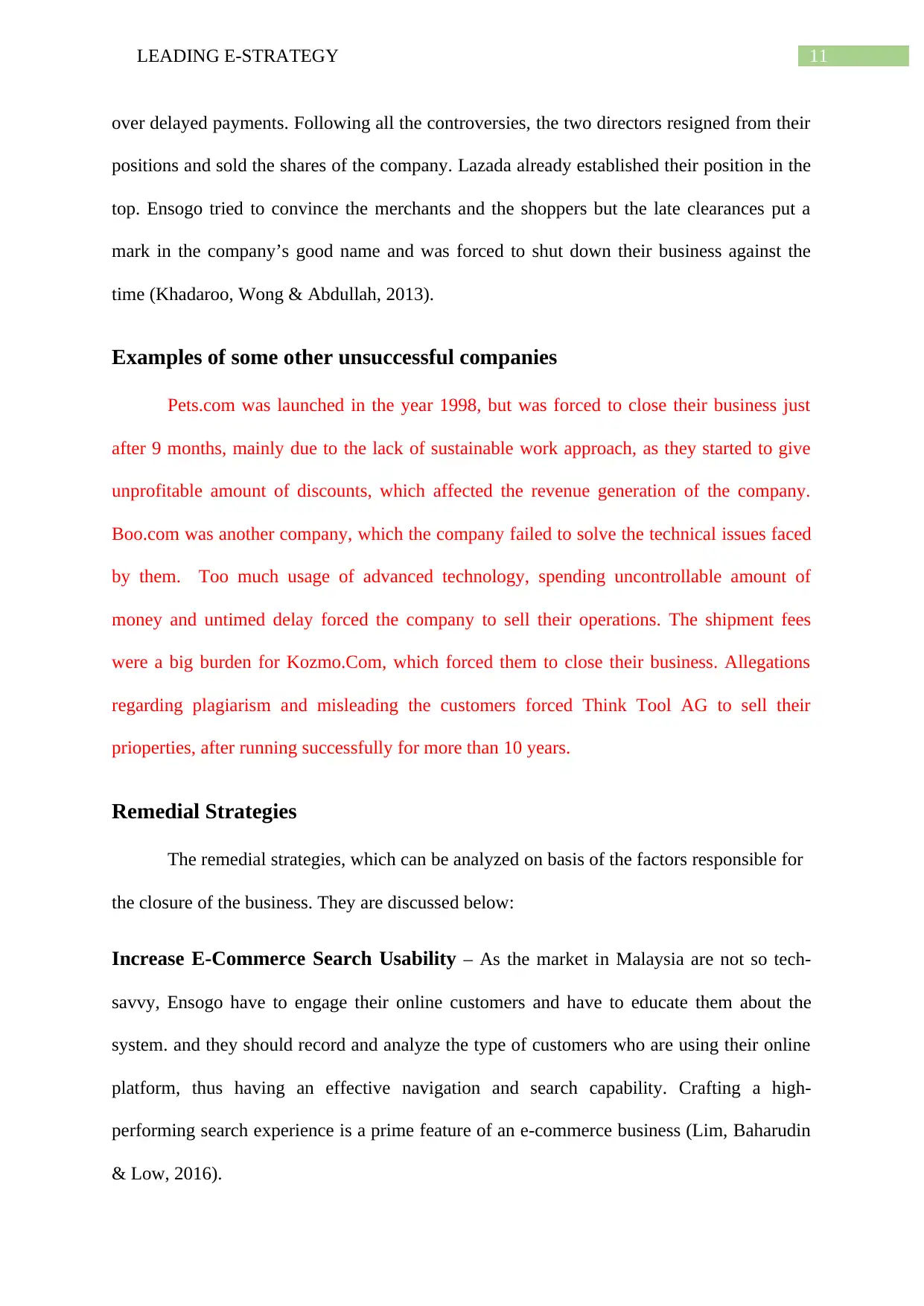
11LEADING E-STRATEGY
over delayed payments. Following all the controversies, the two directors resigned from their
positions and sold the shares of the company. Lazada already established their position in the
top. Ensogo tried to convince the merchants and the shoppers but the late clearances put a
mark in the company’s good name and was forced to shut down their business against the
time (Khadaroo, Wong & Abdullah, 2013).
Examples of some other unsuccessful companies
Pets.com was launched in the year 1998, but was forced to close their business just
after 9 months, mainly due to the lack of sustainable work approach, as they started to give
unprofitable amount of discounts, which affected the revenue generation of the company.
Boo.com was another company, which the company failed to solve the technical issues faced
by them. Too much usage of advanced technology, spending uncontrollable amount of
money and untimed delay forced the company to sell their operations. The shipment fees
were a big burden for Kozmo.Com, which forced them to close their business. Allegations
regarding plagiarism and misleading the customers forced Think Tool AG to sell their
prioperties, after running successfully for more than 10 years.
Remedial Strategies
The remedial strategies, which can be analyzed on basis of the factors responsible for
the closure of the business. They are discussed below:
Increase E-Commerce Search Usability – As the market in Malaysia are not so tech-
savvy, Ensogo have to engage their online customers and have to educate them about the
system. and they should record and analyze the type of customers who are using their online
platform, thus having an effective navigation and search capability. Crafting a high-
performing search experience is a prime feature of an e-commerce business (Lim, Baharudin
& Low, 2016).
over delayed payments. Following all the controversies, the two directors resigned from their
positions and sold the shares of the company. Lazada already established their position in the
top. Ensogo tried to convince the merchants and the shoppers but the late clearances put a
mark in the company’s good name and was forced to shut down their business against the
time (Khadaroo, Wong & Abdullah, 2013).
Examples of some other unsuccessful companies
Pets.com was launched in the year 1998, but was forced to close their business just
after 9 months, mainly due to the lack of sustainable work approach, as they started to give
unprofitable amount of discounts, which affected the revenue generation of the company.
Boo.com was another company, which the company failed to solve the technical issues faced
by them. Too much usage of advanced technology, spending uncontrollable amount of
money and untimed delay forced the company to sell their operations. The shipment fees
were a big burden for Kozmo.Com, which forced them to close their business. Allegations
regarding plagiarism and misleading the customers forced Think Tool AG to sell their
prioperties, after running successfully for more than 10 years.
Remedial Strategies
The remedial strategies, which can be analyzed on basis of the factors responsible for
the closure of the business. They are discussed below:
Increase E-Commerce Search Usability – As the market in Malaysia are not so tech-
savvy, Ensogo have to engage their online customers and have to educate them about the
system. and they should record and analyze the type of customers who are using their online
platform, thus having an effective navigation and search capability. Crafting a high-
performing search experience is a prime feature of an e-commerce business (Lim, Baharudin
& Low, 2016).
⊘ This is a preview!⊘
Do you want full access?
Subscribe today to unlock all pages.

Trusted by 1+ million students worldwide
1 out of 21
Related Documents
Your All-in-One AI-Powered Toolkit for Academic Success.
+13062052269
info@desklib.com
Available 24*7 on WhatsApp / Email
![[object Object]](/_next/static/media/star-bottom.7253800d.svg)
Unlock your academic potential
Copyright © 2020–2025 A2Z Services. All Rights Reserved. Developed and managed by ZUCOL.




